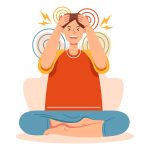
Feeling Weighed Down by Depression? You Can Feel Better- Here’s How
Depression isn’t just “feeling sad.” It’s heavier. It’s like waking up with an invisible weight strapped to your chest every single morning. Simple stuff – showering, answering a text, even watching your favorite show – feels like climbing Everest. Joy? It feels like a distant memory, like something that happens to other people.
Here’s the thing you need to hear, loud and clear: Depression is treatable. It’s not a life sentence. It’s not a sign you’re weak or broken. It’s a health condition, full stop. Just like you’d get help for a broken arm or high blood pressure, you deserve help for this. And finding the right support, maybe a really good Depression treatment center in California, if that’s where you are, can genuinely change everything.
Cutting Through the Fog: What Depression Feels Like
Forget the movie clichés. Depression wears many masks. It might look like:
- That soul-deep exhaustion that sleep just won’t fix.
- Losing the spark for hobbies, friends, or anything that used to light you up. It all just feels… grey.
- Your brain feels like it’s slogging through cold oatmeal. Focusing? Making decisions? Forget it.
- Sleep going completely haywire – either you can’t catch a wink or you could sleep for 15 hours straight.
- Your appetite vanishes or suddenly want to eat everything.
- A constant hum of worthlessness, guilt, or feeling like a burden.
- That scary, quiet voice whispering hopeless thoughts, maybe even about ending the pain.
It hits everyone differently. But however it shows up for you, it’s real. It’s valid. And you shouldn’t have to carry it alone.
Why Reaching Out is Your Strongest Move
Thinking you should just “snap out of it” or “tough it out”? That’s the depression talking, lying to you. Trying to muscle through it alone is like trying to run a marathon with a broken ankle – it just makes things worse and hurts more. Asking for help? That takes guts. That’s a real strength.
Taking that step – maybe calling a depression treatment center in California, talking to your doctor, or just confiding in one trusted person – is the bravest, smartest thing you can do. It’s admitting, “This is too heavy for me right now, and I need support.” There’s zero shame in that.
Your Toolkit: How We Fight Back Against Depression
There’s no magic one-size-fits-all cure, but there are proven tools. Often, it’s about finding the right combination that clicks for you. Here’s the lowdown:
- The Power of Talking (Therapy): This isn’t just lying on a couch talking about your childhood (unless you want to!). It’s practical. It’s about:
- CBT (Cognitive Behavioral Therapy): Spotting those automatic negative thoughts (“I’m a failure,” “Nothing ever works”) that drag you down and learning how to challenge them with reality. Think of it like rewiring faulty brain software.
- Other Awesome Talk Styles: Maybe you focus on relationships (IPT), learn mindfulness to stay present and calm the storm, or explore deeper patterns. A good therapist is like a skilled guide helping you navigate your mind. Many depression treatment centers in California offer tons of therapy options, in-person or virtually from your couch.
- Medication (Meds): Let’s Demystify This. Sometimes, your brain chemistry needs a tune-up. Antidepressants aren’t “happy pills.” They don’t change who you are. Think of them like glasses for your mood – they help clear the fog so you can do the work in therapy and daily life. Finding the right one might take some trial and error with your doctor, and patience is key (they don’t work overnight). But for many, they’re a crucial piece of the puzzle.
- The Everyday Stuff That Matters (Lifestyle): Yeah, you’ve heard it before, but it’s true because science says so. Tiny shifts add up:
- Move Your Body (Gently!): You don’t need to run a marathon. A 20-minute walk, stretching, dancing in your kitchen – anything that gets you out of your head and gets those natural mood-lifting chemicals (endorphins) flowing.
- Fuel Your Brain: What you eat affects how you feel. Less processed junk, and more real food (fruits, veggies, whole grains, lean protein) can make a surprising difference in energy and mood stability.
- Sleep is Sacred: Easier said than done, I know. But crappy sleep makes depression SO much worse. Working on sleep hygiene (routine, dark/cool room, less screen time before bed) is HUGE. Many depression treatment centers in California have experts just for this.
- The structure is Your Friend: Depression loves chaos. Having a loose routine – even just consistent wake-up times, meal times, and bedtime – gives your day anchors and makes things feel less overwhelming.
- TMS (When the Usual Paths Need Backup): If therapy and meds haven’t given you enough relief, don’t lose hope. Transcranial Magnetic Stimulation (TMS) is a game-changer for many. It’s non-invasive (no surgery, no anesthesia). You sit in a comfy chair, they place a device gently on your head, and it delivers targeted magnetic pulses to wake up the mood-regulating parts of your brain. It’s FDA-approved, safe, and often covered by insurance. Leading depression treatment centers in California specialize in this advanced option.
- Help Without Leaving Home (Telepsychiatry & Online Therapy): Stuck in bed? Anxiety through the roof? Live miles from help? No problem. Virtual care is real care. You can connect with therapists and doctors via secure video calls. It’s convenient, private, and gets rid of so many barriers. Seriously, many top California depression treatment centers offer excellent virtual programs.
- Healing the Whole You (Holistic Stuff): Depression isn’t just in your head; it affects your whole being. That’s why many places blend traditional treatments with:
- Yoga & Meditation: Learning to breathe and calm your nervous system.
- Acupuncture: Ancient practice that many find deeply relaxing and balancing.
- Art or Music Therapy: Expressing feelings when words are hard.
- Nutritional Counseling: How food directly impacts your mood chemistry.
- Massage Therapy: Releasing physical tension that holds emotional weight.
- This “whole person” approach is a hallmark of many depression treatment centers in California. It’s about nurturing you, not just fighting symptoms.
- Finding Your Tribe (Support Groups): Knowing you’re not alone is powerful medicine. Hearing others share experiences eerily similar to yours? Realizing “It’s not just me”? Sharing your own story without judgment? Support groups offer profound connection and understanding. Treatment centers often host these, both in-person and online.
Walking Through the Door: What Happens at a Treatment Center
If you’ve never done this, it’s normal to feel nervous. Here’s the typical flow:
- The First Conversation (Assessment): You’ll talk with a compassionate professional (therapist, doctor, intake specialist). They’ll ask about your experience – your symptoms, how long, what life feels like, your history. This is about listening to you.
- Making Sense of It (Diagnosis): They’ll help figure out if it’s depression, something else, or a combination. This clarity is the first step to the right treatment.
- Building Your Plan: Together, you decide the path forward. “Together” is key. It’s not forced on you. It’s a collaboration based on your comfort level, needs, and goals. Therapy? Meds? TMS? Holistic stuff? A mix? It’s your map.
- Walking the Path (Ongoing Care): You start your treatment – with regular therapy sessions, medication management, TMS appointments, and group sessions. It’s not static. You’ll check in, talk about how it’s going, and tweak the plan as needed. Good places meet you where you are. Expect kindness, respect, and strict privacy.
Finding Your Spot: Choosing a Depression Treatment Center in California
Not all centers are created equal. Here’s what truly matters:
- Real Experts: Look for licensed, experienced psychiatrists, psychologists, therapists, and nurses. Check credentials.
- It’s ALL About You: Avoid cookie-cutter programs. They should tailor the plan specifically to your story and needs.
- Range of Options: Do they offer a variety of evidence-based treatments? Therapy (different kinds), medication management, TMS, telehealth? Holistic add-ons?
- The Whole Person Approach: Do they acknowledge and treat the connection between mind and body? Is wellness (sleep, nutrition, movement) part of the plan?
- People Vouch for Them: Read genuine reviews. What are other patients saying about their experience and results?
- Accessibility: Can you get there reasonably easily? Do they offer robust virtual options if needed? Is the intake process clear and supportive?
- The Vibe: When you call or visit (even virtually), do you feel heard, respected, and hopeful? Trust your gut.
Ask your primary care doctor for recommendations. Search online specifically for “depression treatment center California” and look beyond the ads. Call a few places. Ask questions. See how they respond. You have the right to find a place that feels right for you.
You Are Worth This Fight
Depression lies. It tells you you’re stuck, broken, hopeless, and alone. But here’s the truth, straight up: You are none of those things. You are a human being experiencing a very real, very treatable health challenge. Millions of people walk this path and find their way back to light, connection, and joy. You absolutely can too.
It takes courage to start. It takes patience. There might be bumps. But reaching out for help – whether it’s to a friend, a doctor, or a dedicated depression treatment center in California – is the single most powerful step you can take. It’s an act of profound self-care and hope.
Conclusion
When patients first visit Karma Docs in Palm Springs, California, our priority is getting to know them personally. Understanding someone’s history, daily challenges, aspirations, and even their small joys provides crucial insights that standard questionnaires alone can’t capture. We believe that depression treatment is most effective when tailored to each individual’s unique story.
Taking that first step – making a call, sending an email, even just reading this article – is already you moving forward. That spark of “maybe”? Hold onto it. That’s hope. That’s you fighting back.
One breath. One step. One day at a time. You’ve got this. And hands are reaching out, ready to help you climb. You are worth that sunrise.



